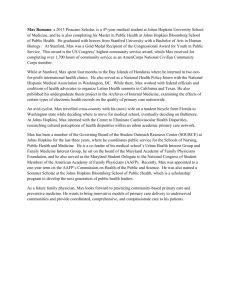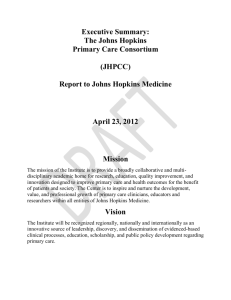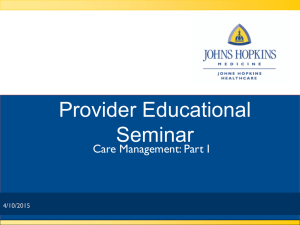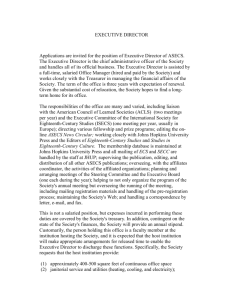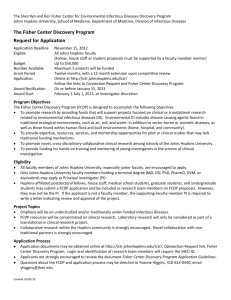Online Appendix 1 In this online appendix, we provide further detail
advertisement
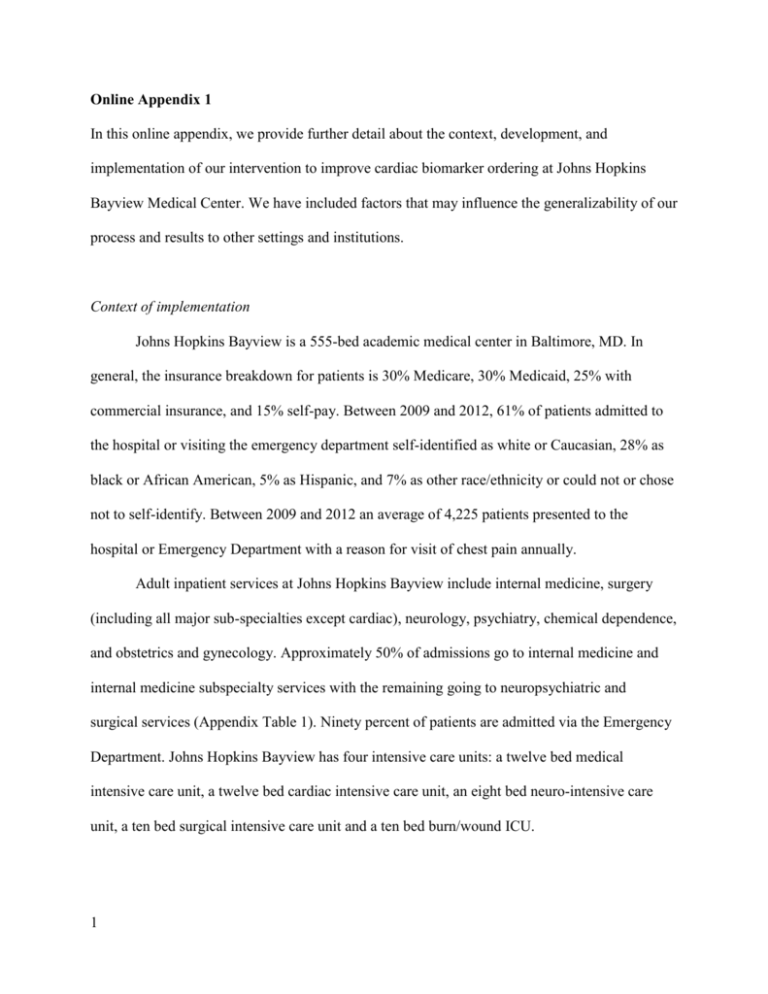
Online Appendix 1 In this online appendix, we provide further detail about the context, development, and implementation of our intervention to improve cardiac biomarker ordering at Johns Hopkins Bayview Medical Center. We have included factors that may influence the generalizability of our process and results to other settings and institutions. Context of implementation Johns Hopkins Bayview is a 555-bed academic medical center in Baltimore, MD. In general, the insurance breakdown for patients is 30% Medicare, 30% Medicaid, 25% with commercial insurance, and 15% self-pay. Between 2009 and 2012, 61% of patients admitted to the hospital or visiting the emergency department self-identified as white or Caucasian, 28% as black or African American, 5% as Hispanic, and 7% as other race/ethnicity or could not or chose not to self-identify. Between 2009 and 2012 an average of 4,225 patients presented to the hospital or Emergency Department with a reason for visit of chest pain annually. Adult inpatient services at Johns Hopkins Bayview include internal medicine, surgery (including all major sub-specialties except cardiac), neurology, psychiatry, chemical dependence, and obstetrics and gynecology. Approximately 50% of admissions go to internal medicine and internal medicine subspecialty services with the remaining going to neuropsychiatric and surgical services (Appendix Table 1). Ninety percent of patients are admitted via the Emergency Department. Johns Hopkins Bayview has four intensive care units: a twelve bed medical intensive care unit, a twelve bed cardiac intensive care unit, an eight bed neuro-intensive care unit, a ten bed surgical intensive care unit and a ten bed burn/wound ICU. 1 Providers included Johns Hopkins Bayview Medical Center-based Department of Medicine housestaff, housestaff for other departments rotating primarily from Johns Hopkins Hospital, and attendings, nurse practitioners, and physician assistants in all departments (See Appendix Table 2 for breakdown of provider type by year). Admissions to General Internal Medicine services were split between a large hospitalist group and teaching services comprised of housestaff. The proportion of admissions going to the hospitalist group increased from 50% to 60% from 2009 to 2012. Johns Hopkins Bayview Medical Center employed a client-server version of Meditech (Westwood, MA) for computer provider order entry throughout the study timeframe. Available orders for cardiac biomarkers were troponin-I, total CK, and total CK and CK-MB fraction ordered together (CK-MB could not be ordered independent of total CK). Before the study intervention, there were twenty order sets containing orders for CK/CK-MB, two for CK and eight with troponin orders. There was also an order for nurses to “Start CK Curve for CP, PRN” that was found in two order sets, or could also be ordered individually. For many patients, the first one or two orders for cardiac biomarkers were initiated by emergency department providers. In the pre-intervention period, 87% of cardiac biomarkers ordered were for patients admitted to General Internal Medicine, Cardiology, or Pulmonary services. Intervention development and implementation In the Fall of 2009, Physicians for Responsible Ordering was formed by a group of providers committed to reducing low value inpatient diagnostic test ordering at Johns Hopkins Bayview Medical Center. The group consisted of residents, faculty, and leadership from a broad array of departments, including: internal medicine, emergency medicine, pathology, and hospital 2 administration. Based on clinical experience, we identified cardiac biomarkers as an initial target. Our approach to developing the intervention is summarized in Appendix Table 3. Prior to instituting changes to the provider order entry system, we sent all providers at Johns Hopkins Bayview an e-mail that outlined the mission and goals of Physicians for Responsible Ordering, a summary of the cardiac biomarker ordering guideline, a copy of the quick reference pocket-sized card (main text Figure 1), and a review of changes to cardiac biomarker ordering planned for Meditech. We also engaged in direct outreach to Internal Medicine and Emergency Department providers whom most frequently ordered cardiac biomarkers. Physician members of the study team briefed groups of providers on the initiative and provided an opportunity to ask questions. This information was typically communicated in 5-10 minute sessions as part of regularly scheduled administrative meetings. Specifically, we conducted meetings with at an internal medicine housestaff morning report, a monthly internal medicine housestaff administrative lunch meeting, and monthly administrative meetings for hospitalists, MICU and CICU nursing staff, and the emergency department. We estimate that anywhere from 25%-75% of providers in these groups were present for these meetings. We monitored the implementation and success of the intervention in two ways. First, we obtained quarterly reports on ordering of cardiac biomarker testing and compared them to preintervention results. We also kept open lines of communication with providers and addressed any clinical concerns that may have appeared as a result of the guideline changes. No changes to the intervention were made as a result of this monitoring process. Noting that in July 2012 there would be turnover of residency staff throughout the hospital, new internal medicine residents were briefed on the goals of the program and ordering guidelines during their orientation. 3 We believe several additional contextual factors may have contributed to the success of our intervention. One of our study team members was on the cardiology faculty, and we included faculty members, including the Chief of the Division of Cardiology in development of our guideline. We engaged hospital and departmental leadership from the start of the planning process who encouraged our efforts and professed support for the project to providers hospitalwide. We provided updates through presentations at Medicine Grand Rounds, departmental meetings, and direct conversations with departmental leaders. We believe leadership support of this initiative was instrumental in inducing provider behavior change. Resources The resources required to design and implement the intervention were primarily related to individuals’ time. Guideline development and execution of the chart review required approximately 60 hours from an Internal Medicine resident team member and 20 hours from a Cardiology faculty team member. A team member from the Internal Medicine Hospitalist faculty who is also the provider liaison with Meditech spent 15 hours reviewing order sets and facilitated making changes to order sets and arranging for incorporation of the warning messages within the order entry system. An analyst from Information Services spent 10 hours building and testing the changes. An Internal Medicine Resident team member and Cardiology faculty team member spent approximately 5 hours each in creating materials for and conducting educational sessions with providers. An analyst from the Department of Care Management provided expertise on the content of the Meditech data repository and executed data queries, requiring approximately 40 hours of analyst time. These services were provided in-kind, comprising administrative time directed toward institutional quality improvement initiatives. We obtained two small grants of 4 which initial funding has been used to offset printing of quick reference cards (less than $200) and a statistician to consult on conducting the interrupted times series analysis for this manuscript. 5 Appendix Table 1. Distribution of adult inpatient admissions by service at Johns Hopkins Bayview from January 2009 through October 2012. Admissions Service number/month % General Internal Medicine 606 30.5% Internal Medicine Observation 217 10.9% Cardiology 108 5.4% Pulmonary 72 3.6% Chemical Dependency Unit 221 11.1% Psychiatry 76 3.8% Neurology 75 3.8% Obstetrics and Gynecology 155 7.8% General Surgery 155 7.8% Surgery Observation 64 3.2% Orthopedic Surgery 83 4.2% Neurosurgery 58 2.9% Urology 24 1.2% Trauma 12 0.6% Plastic Surgery 8 0.4% Otolaryngology 7 0.4% Burn/wound 43 2.2% 6 Appendix Table 2. Breakdown of type of providers with ordering privileges at Johns Hopkins Bayview Medical Center annually from 2009-2012. 2009 2010 2011 2012 Full-time faculty MDs 504 488 502 537 JHBMC Residents 75 71 80 80 JHH Resident Rotators* 75 75 75 75 Midlevel providers (NPs or PAs) 220 237 229 268 * Residents primarily based at Johns Hopkins Hospital who complete inpatient clinical rotations at Johns Hopkins Bayview Medical Center. 7 Appendix Table 3. Summary of process to develop intervention. Task Dates Description 1. Chart Review (Estimate current utilization) December 2009 Reviewed charts of 35 patients admitted general medicine unit on a single day in December 2009 (none received a diagnosis of ACS). More than 80% of patients had at least one CK and CK-MB test ordered and more than 20% of patients had four or more CK, CK-MB or troponin tests (Appendix Table 4). Reviewed published evidence. Discussed with cardiology faculty. 2. Guideline Development January 2010 – December 2010 3. Beta-test guideline January 2011July 2011 4. Reviewed Meditech order sets January 2011 – July 2011 8 Reviewed guideline with housestaff and faculty. Iteratively revised quick-reference card (final depicted in Figure 1 in main text). Obtained buy-in from those with direct contact; however, identified skepticism of widespread acceptance without further educational efforts leading us to focus on improving knowledge and attitudes as part of intervention. Identified all order sets with orders for troponin, CK, or CK-MB Contacted administrative “owners” of order sets to explain initiative and obtain permission to remove cardiac biomarkers from these order sets (see Appendix text for detailed list of order sets edited) Appendix Table 4. Cardiac biomarker testing for 35 patients admitted to a general medicine service on a single day in December 2009. Troponin CK CK-MB 2.4 3.2 3.0 Patients with > 1 test, n (%) 28 (80%) 29 (83%) 28 (80%) Patients with > 3 tests, n (%) 8 (23%) 9 (26%) 8 (23%) Mean tests per patient 9
